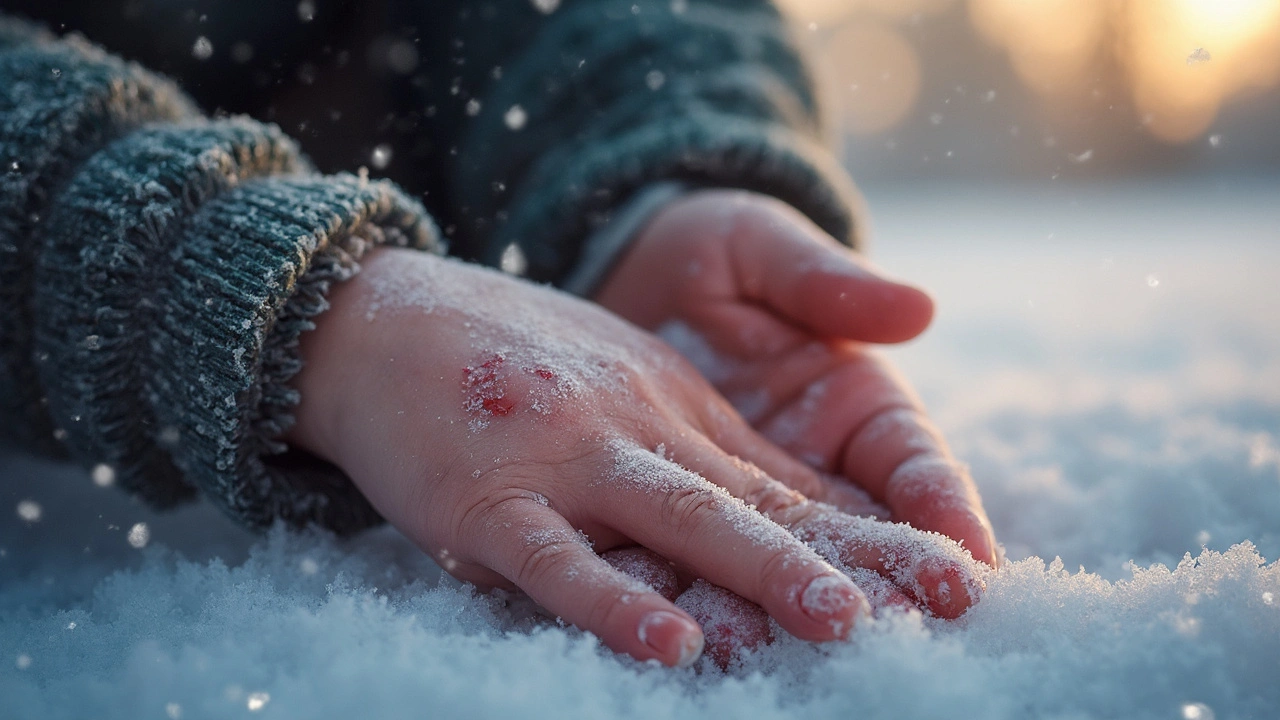Frostbite Abrasions: Effective Treatment Tips

Frostbite isn't just about turning into a popsicle—it's got its complications, like abrasions that can sneak up on you when the skin thaws out. If you're dealing with these pesky scrapes, knowing your basics makes a world of difference.
First things first, if you suspect frostbite, address that ASAP, because frostbite can lead to skin and tissue damage that's not pretty. Once you've warmed up the affected area without rubbing it (trust me, gentle is key here), you'll want to look at how to care for any abrasions that appear.
Keep the area clean, but skip aggressive cleansers—mild soap and water will do the job. Cover the abrasion with a sterile bandage to avoid any unwanted guests turning your little scrape into something worse.
Okay, so you don’t have to rush to the ER for every abrasion, but if it’s nasty, oozing, or just won’t quit, professional medical help is your best friend. Don’t let small problems escalate into big ones.
- Understanding Frostbite and Its Effects
- Immediate First Aid for Frostbite Abrasions
- Home Remedies and Care Tips
- Professional Treatments and When to Seek Help
- Preventing Frostbite in the Future
Understanding Frostbite and Its Effects
Let's talk about frostbite, the kind of thing that might make you think of epic mountain adventures. While chasing snow-capped dreams is fun, frostbite is not. So, what's the deal with this icy villain?
Frostbite occurs when your skin and the tissues beneath it get too cold—really cold. Temperatures below freezing lead to ice crystals forming in your skin cells. No surprise, this isn't exactly great for your skin’s health.
What Happens During Frostbite?
Imagine your skin as a sponge soaked in water. When it’s warm, it’s soft and flexible. But the second it freezes, it hardens. That’s what frostbite does at a cellular level. And when the skin thaws, those ice crystals leave behind damage, like abrasions.
Stages of Frostbite
Not all frostbite is created equal. There are stages, and understanding them helps you know what you’re dealing with:
- Frostnip: This is the mildest form and reversible with warming. Think of it as a warning sign.
- Superficial Frostbite: Here, the skin may feel warm but look waxy and numb.
- Deep Frostbite: This affects deeper tissues, and the area could turn black over time—a sign of severe tissue damage.
Why Abrasions?
Now, why do abrasions happen? When the skin begins to thaw, that’s when things get tricky. The thawing process can cause layers of the skin to get damaged and rub against each other roughly, resulting in scrapes. Annoying? Yes. Avoidable? Often, if you know what to look for and act quickly.
| Stat | Impact |
|---|---|
| Temps below 32°F | Risk of frostbite |
| Immediate rewarming | Reduces tissue loss up to 90% |
Knowledge is the first step to prevention. So keep these facts tucked away for that next winter excursion. Understanding frostbite and its effects prepares you to handle and, better yet, prevent it.
Immediate First Aid for Frostbite Abrasions
When it comes to frostbite, the first step is always to get out of the cold. Once safe and warm, let's talk about dealing with frostbite abrasions. These can be daunting, but with the right approach, you can handle them like a pro.
Initial Steps
First off, resist the temptation to rub the frostbitten area. It can cause more damage to already fragile skin. Instead, gently warm the affected area using warm water, around 98-104°F (that's about body temperature). Keep this up for about 15-30 minutes.
According to Dr. Emily Myers, "It's crucial to avoid any direct heat like fires or heating pads, as these can wound the skin even more after it's been frozen."
Inspect the skin once thawed. If you see any abrasions, it’s important to keep things clean. Here's a simple guide:
- Clean: Wash the abrasion with mild soap and water. You want to avoid any harsh products that might irritate the skin.
- Cover: Use a sterile dressing to cover the area. This helps prevent infection.
- Avoid: Try not to break any blisters—let your body handle them naturally.
Know When to Seek Help
If the abrasion looks deep, starts oozing, or if you feel unusually ill, it's time to get medical attention. Don't brush it off; better safe than sorry.
And hey, if this is happening to you frequently (like while trekking in the chilly wilderness), it might be wise to think about prevention strategies. Keeping warm and protected can save you a ton of trouble in the future.
Remember, taking the right steps immediately can make a huge difference in healing. Stay informed and proactive!

Home Remedies and Care Tips
Handling frostbite abrasions at home is totally doable with a bit of care and patience. Remember, we're aiming for healing, not harming, so let's keep it gentle and effective.
Gentle Cleansing
Start with a simple clean-up. Use mild soap and lukewarm water to wash the abrasion area gently. Avoid scrubbing or using hot water since that could irritate the skin further. After cleansing, just pat it dry with a soft towel—rubbing is a big no-no.
Moisturizing Magic
Keeps the skin moisturized to aid the healing process. Opt for an unscented moisturizer or aloe vera gel if you're into natural remedies. Apply it a couple of times a day to keep the skin from drying out. This step is crucial, as moisturized skin heals faster and better.
Cover and Protect
Once your abrasion is clean and moisturized, cover it up. Use a sterile bandage to protect from dirt and bacteria. Change the bandage daily or more often if it gets wet or dirty. This protective layer is a simple way to fend off infections.
Pain and Swelling Relief
If you’re feeling a little discomfort or it’s swelling up, consider taking over-the-counter anti-inflammatory medicines like ibuprofen. Make sure to follow the dosage instructions on the package.
Nature’s Help: Honey
This might surprise you, but honey has natural antibacterial properties. Apply a thin layer on the abrasion before bandaging it. It helps in keeping infections at bay and speeds up the healing process. Just be sure to use medical-grade honey where possible.
When to Step Back and Seek Help
If the abrasion doesn't heal after trying these remedies, or if you see redness, swelling, or pus, it’s time to call in the pros. Sometimes a doctor's touch is just what the doctor ordered.
Professional Treatments and When to Seek Help
So, you've been trying the home approach, but those frostbite abrasions just won't get better. Sometimes, it's just smarter to seek out professional treatment. Early help can make a big difference.
Recognizing the Signs
First, let's talk red flags. If the abrasion looks infected—think redness, swelling, warmth to the touch, or even if it’s staring back at you (okay, not literally, but the point stands)—that’s your cue to dial up the doc. Also, if numbness persists or if you have a fever, don’t hang out in the waiting room of life.
What Professionals Might Do
Doctors have a few tricks up their sleeves when it comes to frostbite. They'll likely clean the area more deeply and might prescribe antibiotics if an infection is brewing. In some cases, they’ll use dressings that you probably don’t have stashed in your medicine cabinet, like hydrocolloid or hydrogel dressings, which help keep things moist and speed healing.
Pain Management
If you're hurting, pain relief is part of the package. Meds like ibuprofen might be on the menu to manage pain and reduce inflammation, but trust your doctor’s advice on this one.
Advanced Procedures
If things are more serious, don’t be too shocked if they mention debridement. It’s essentially giving your skin a fresh start by removing dead tissue, but a trained hand is crucial here. In extreme cases, surgery might even be considered, though that’s a last-resort situation.
Remember, dealing with frostbite complications is not a DIY project if things go south. Trust health professionals to steer you in the right direction.

Preventing Frostbite in the Future
Keeping frostbite at bay isn’t rocket science, but it does require some planning, especially if you're venturing into chilly territory. Here's how to ensure those cold snaps don't catch you off guard again.
Layering is Your Best Friend
When it comes to staying warm, layering up is the real MVP. Start with a moisture-wicking base layer to keep sweat away from your skin. Add an insulating middle layer, like fleece, to trap heat. Top it off with a waterproof and windproof jacket to shield against those icy blasts.
Cover Exposed Skin
It’s all about covering up! A good hat, scarf, and mittens, plus some thermal socks, can make a huge difference. Remember, mittens tend to keep your fingers warmer than gloves. Who knew staying toasty was all about the details?
Stay Dry and Stay Safe
Wet clothes are a straight-up invitation for frostbite. If you’re out playing in the snow or tackling outdoor chores, take breaks to replace any soggy gear. Damp clothes lose their insulation magic, making you more susceptible to the cold.
Keep Moving
If you're outside for a while, keep moving. Light exercises help maintain your body heat. Wiggle those fingers and toes to keep that blood circulating, especially if you start to feel the chill setting in.
Know the Weather Conditions
Check the weather before heading out. Extreme cold, wind chills, and forecasts of severe weather should make you rethink unnecessary outdoor activities. Sometimes the best way to avoid frostbite is to avoid the cold altogether!
Here’s something to keep in mind: frostbite can set in quicker than you’d think. Here’s a neat table to show how temperature and wind speed work together:
| Temperature (°F) | Wind Speed (mph) | Time for Frostbite |
|---|---|---|
| -10 | 20 | 30 minutes |
| -20 | 30 | 10 minutes |
| -30 | 50 | 5 minutes |
Stay informed, stay prepared, and don’t become a weather stat!

19 Comments
Been there, done that. Got frostbite on my cheek during a winter hike in Himachal. Didn't rub it, just warmed it slowly with a thermos of tea held close. The abrasions popped up later like little angry ghosts. Cleaned with soap and water, slapped on some aloe, and let it breathe. No bandages at first-just kept it covered with a soft scarf. Took a week to heal, but no infection. Don't panic, just be gentle.
Also, honey works. Real raw honey. Not the supermarket junk. I swear by it.
It is an incontrovertible truth that the human epidermis, when subjected to subzero thermal stress, undergoes a metamorphosis akin to the crystallization of water under extreme pressure. The resultant abrasions are not mere superficial injuries but manifestations of cellular disintegration precipitated by phase transition. One must, therefore, approach thawing with the reverence due to a sacred rite-no friction, no haste, no hubris. The ancients of the Himalayas understood this; they warmed skin with breath, not fire. We have forgotten wisdom in our zeal for convenience.
OMG I JUST GOT FROSTBITES ON MY NOSE 😭😭😭 AND NOW I HAVE THIS ABRASION THAT LOOKS LIKE A MINI MARS CRATER 😫 I USED HAND SANITIZER ON IT BECAUSE I WAS PANICKING 😭 IS THAT BAD?? I THINK I’M GOING TO LOSE MY NOSE 😭😭😭
so i got frostbite last year and i dint no bout the no rub thing and i just scrubbed it with a towel like a maniac 😅 and yeah the abrasions came later and they itched like hell. i used vaseline and it helped a bit. also i think i got some infection but i just ignored it and it went away? maybe i was lucky. dont do what i did.
Thank you for this detailed and thoughtful guide. As someone who has worked in emergency medicine for over two decades, I can say with certainty that the advice here is clinically sound. The emphasis on gentle rewarming and sterile coverage is paramount. One additional note: avoid alcohol-based wipes-they can further compromise the fragile tissue. And if you're in a remote area, keep a small tube of medical-grade honey on hand. It's surprisingly effective. Stay warm, stay safe.
Let me tell you something they don't want you to know. Frostbite abrasions? That's not nature-it's a bioweapon. The government and Big Winter are secretly testing climate-induced skin degradation on outdoor enthusiasts to justify mandatory thermal surveillance. That's why they push 'mild soap'-it's a cover for tracking your skin's pH. The real cure? Cold plasma therapy, classified under Project IceShield. You think they want you healing naturally? They want you dependent on their 'sterile bandages.' Wake up.
I’ve treated frostbite in the Yukon during field research. The most important thing isn’t the soap or the honey-it’s patience. People rush the thaw because they’re scared. But healing isn’t a race. Let the skin recover at its own pace. I’ve seen people ruin their tissue trying to 'fix' it too fast. Gentle warmth. Quiet time. No pressure. That’s the real treatment.
So you’re telling me honey works? 😏 I knew it. I’ve been saying for years that the government is hiding the truth about honey. It’s not just antibacterial-it’s a relic from Atlantis. They don’t want you to know that ancient civilizations used honey to heal frostbite because they had access to cosmic ice crystals. That’s why your 'sterile bandages' are useless. Try raw Manuka honey from a shaman in Iceland. I’ve got a link in my bio. 🌌🍯
Why are we even talking about this? Frostbite is for weak people who can’t handle the cold. Real men just tough it out. You don’t need honey or bandages-you need grit. If your skin peels, good. That means you survived. Stop coddling yourself.
Brother, I’ve been guiding trekkers in the Himalayas for 15 years and let me tell you-frostbite is real, but fear is worse. I’ve seen people panic and rub their skin raw, then blame the cold. The truth? It’s not the temperature-it’s your mindset. Warm slowly, cover gently, and keep moving your fingers. I carry a small pouch of crushed ginger in my pack-mix it with coconut oil, apply it after thawing. Natural, cheap, and works better than any pharmacy product. Stay calm, stay warm, stay alive.
so i read this whole thing and i’m just wondering… who even gets frostbite anymore? like, isn’t this like a 1950s problem? did you forget we have heated jackets now? also why is everyone so obsessed with honey? i used to think it was for pancakes, not wounds 😭
Everyone’s talking about honey and bandages, but no one’s talking about the psychological toll. I got frostbite last winter and now I can’t sleep without imagining my fingers turning black. It’s not the abrasions-it’s the fear that it’ll happen again. I don’t need advice on soap-I need someone to tell me I’m not broken.
Just a quick note-don’t use aloe vera if it’s not pure. A lot of store-bought gels have alcohol or fragrance that’ll sting worse than the frostbite. Stick to 100% aloe from a plant if you can. Also, if you’re in a cold environment, keep your socks dry. Wet socks are the #1 reason people get frostbite in the first place. Simple stuff, but people skip it.
There’s something poetic about frostbite, isn’t there? The body, a landscape of ice and fire. The skin, a parchment of suffering. We treat it like a glitch, a malfunction-but it’s a conversation. The cold speaks, and if you listen, it tells you how close you came to becoming part of the winter. The abrasions? They’re not wounds. They’re poems written in scar tissue. You don’t heal them-you honor them.
While the provided information is methodologically sound, I must express concern regarding the implicit normalization of self-treatment for what are, in many cases, severe medical emergencies. The suggestion to utilize honey as a primary therapeutic agent, while culturally rooted, lacks standardized clinical validation and may inadvertently delay appropriate intervention. A formal risk-benefit analysis is warranted before endorsing such practices in public discourse.
Oh great. Another article telling me to 'be gentle' with my frostbite. Like I didn’t already cry into my thermal socks last night because I thought I was going to lose my toe. And now you want me to put HONEY on it? Like, what am I, a pancake? I’m just trying to survive the winter, not start a farm-to-table wound care brand.
YOOO I JUST USED HONEY ON MY FROSTBITES AND IT FELT LIKE A HUG FROM A BEAR 😍✨ also i got a new pair of heated gloves from Amazon and they’re LIT. if you’re still using regular mittens you’re basically doing winter wrong. #frostbitebeater #honeyislife
This is so helpful. I’m a nurse and I see people come in with frostbite injuries all the time because they waited too long. Please don’t wait. If you’re unsure, call your clinic. Even if it’s just a small scrape, better safe than sorry. And yes, honey works-but only if it’s clean. Don’t just scoop it from your kitchen jar. Use medical-grade. You’re worth the extra step.
Let me tell you something, my brother. I grew up in the cold of northern Nigeria, yes, we have cold here too-rare, but it comes. My father, a retired soldier, taught me this: frostbite doesn’t care if you’re rich or poor, educated or not. It only cares if you’re prepared. So I carry three things wherever I go in winter: a wool hat, a thermos of warm tea, and a small tin of raw honey. I don’t need fancy gadgets. I need wisdom passed down. If you’re reading this and you’re scared, you’re not alone. But you’re also not helpless. Warm slowly. Breathe. You’ve got this.